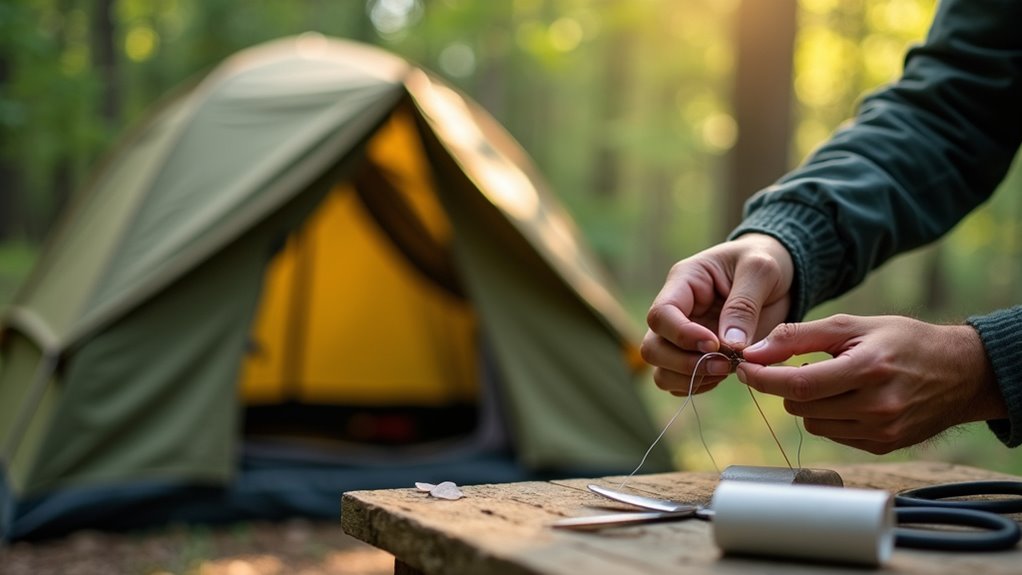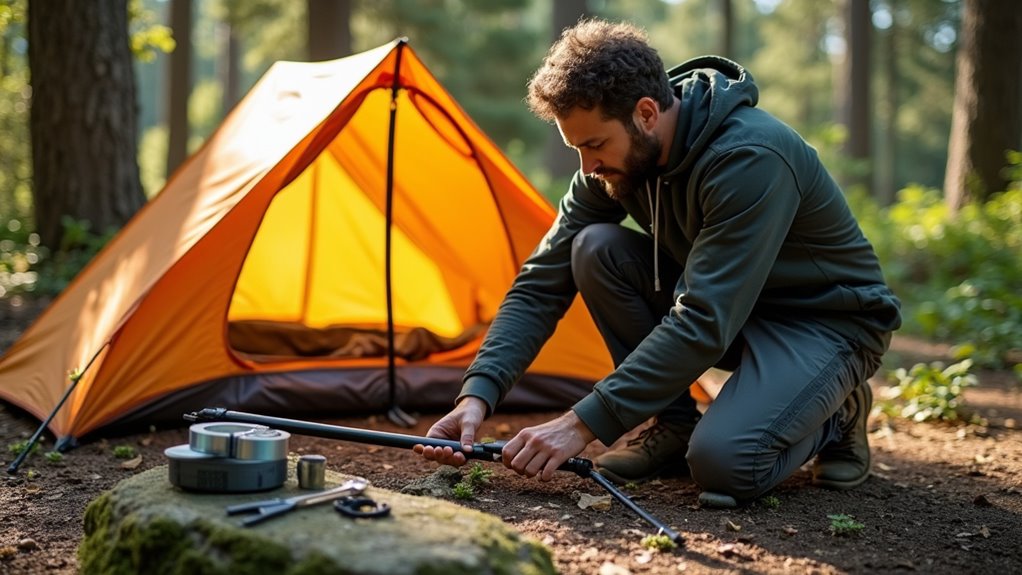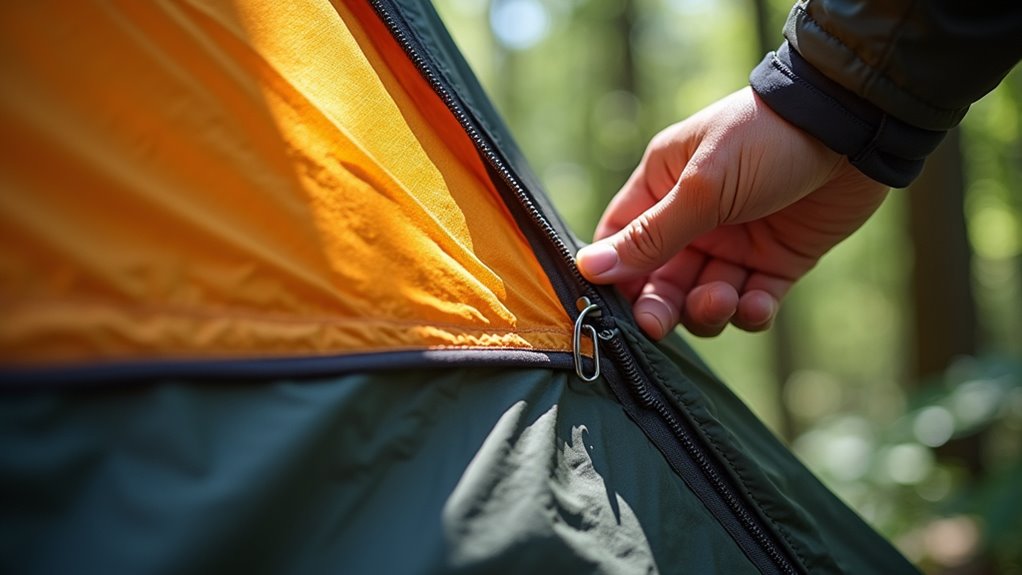How To Fix A Tent
This post contains affiliate links. As an Amazon Associate, we earn from qualifying purchases.
To fix a tent, begin by repairing fabric tears with strong tape like Tenacious Tape™ or sew larger tears using a sewing awl and waxed thread. For mesh panels, clean and patch holes with patches that extend at least one inch beyond the damage for a secure hold. Repair broken poles using a pole repair sleeve or by creating a splint with sticks. Check and reseal seams with seam sealer to maintain waterproofing. Additionally, clean zippers and replace any damaged components to ensure your tent is fully functional. Further details and tips on optimizing your repair process are provided below.
Essential Facts in 30 Seconds
- Clean damaged areas with rubbing alcohol before repairing.
- Use strong repair tape or sew large tears with a sewing awl and waxed thread.
- Patch mesh holes with mesh patches at least one inch larger than the damage.
- Straighten bent poles and reinforce with repair sleeves or splints.
- Regularly inspect seams and reapply waterproofing to maintain tent durability.
Repairing Tent Fabric Tears and Holes

Tears and holes in your tent fabric need quick repair. Clean the area well with rubbing alcohol. This removes dirt and oils for better glue hold. Wait until the fabric is fully dry before patching. Moist fabric weakens the patch bond.
For big tears, sew them first with a sewing awl and waxed thread. Use lock stitches to keep the fabric tight. Cut patches in circles. Make them 1.5 to 2 inches larger than the tear. Spread glue evenly on the patch. Press hard to push out air bubbles. It’s essential to assess the damage before starting any repairs to ensure all affected areas are addressed.
Use strong repair tape like Tenacious Tape™. Round the edges of the tape for longer wear. Let glue dry for 24 hours. Keep steady pressure on the patch while it dries. This method makes a strong repair. Your tent will last longer and stay safe in bad weather. Additionally, always test the patch by giving it a gentle tug after curing to ensure it is secure.
Fixing Mesh Panels
Fixing mesh panels in your tent helps it last longer and keeps you comfortable.
Start by checking the damage. Small holes fix easily with patches. Big tears need extra support. Regularly cleaning your tent can also help prevent dirt buildup that may lead to damage.
Clean the area with rubbing alcohol and let it dry. Cut off loose threads for a smooth surface.
Use a mesh patch that’s one inch bigger than the hole. Round the edges to stop peeling. Press the patch from the middle out to stick it well.
For large holes, put patches on both sides like a sandwich. Let the patch set for 24 hours before folding or packing. If you notice any issues with the zippers, addressing them early can prevent larger repairs.
Severe damage may need a professional repair for better results. Additionally, ensure the tent is completely dry before packing it away to prevent future mold growth.
Pole and Frame Repair Techniques

Knowing how to fix tent poles and frames can make your tent last much longer. For fast repairs, use pole splinting.
First, straighten any bent poles. Line up the broken parts carefully. Slide a pole repair sleeve over the break, keeping it centered. Wrap duct tape around the sleeve to hold it tight. A good repair will ensure that the joint can withstand wind or other forces during camping.
Without a sleeve, strong sticks or tent stakes work well as splints. To strengthen a broken frame, make a metal brace from strong steel. Drill holes to fit the brace on the broken part. Attach it with screws or bolts for a solid hold.
Consider having a repair sleeve handy for additional support during your repairs.
Test the tent by setting it up and taking it down after repairs. Always carry a repair kit with pole sleeves, extra cords, and duct tape to fix problems quickly. This way, your tent stays strong and ready for your next trip.
Seam and Waterproofing Maintenance
Regular seam and waterproofing care keeps your tent dry and strong.
First, check all seams for loose or peeling tape. Remove any loose tape carefully to avoid fabric damage. Clean the seams with rubbing alcohol and a cloth to remove dirt. Apply seam sealer on these spots, especially under the rainfly and inside the tent where leaks often happen.
Next, renew the waterproof coating. Signs of wear include peeling or sticky areas. Wash the tent gently with mild soap and water before adding a new layer. Use a paint-on polyurethane (PU) or waterproof coating made for fabric. Let the tent dry completely—this step is very important. Additionally, ensure that all repairs are completed before applying waterproofing spray to maximize effectiveness. Consider using a silicone-based spray for comprehensive coverage.
For extra water protection, spray a Durable Water Repellent (DWR) like Nikwax TX.Direct.
Doing this maintenance regularly can double your tent’s lifespan. It also keeps you dry in heavy rain. A well-cared-for tent saves money and worry on every trip.
Zipper and Component Adjustments

Zippers protect your tent and keep it working well. Clean zippers often using a soft toothbrush to remove dirt. Rinse with water and wipe with a damp cloth. Regular zipper lubrication can also help prevent sticking issues.
Use zipper lubricants or lip balm to help zippers move smoothly. Avoid pulling hard on stuck zippers to prevent damage.
Bent or broken zipper teeth need fixing with needle-nose pliers. Lost zipper pulls can be replaced with zip ties or paperclips for a quick fix. Keep spare pulls in your repair kit for stronger repairs.
If cleaning doesn’t help, change the zipper slider by buying the right part and installing it carefully. Use lubricants, small brushes, and strong thread to fix zippers and fabric. Regularly inspect and clean the zipper to ensure it functions properly.
Check zippers often to keep them reliable on every camping trip.
Frequently Asked Questions
How Can I Prevent My Tent From Getting Damaged in the First Place?
Prevent tent damage by checking it regularly for tears or holes. Clean your tent after every trip to remove dirt and moisture. Avoid using your tent in strong winds or heavy storms to keep it safe. Store your tent in a dry, cool place away from sunlight. Use a groundsheet to protect the floor from sharp rocks and sticks. Small repairs done quickly stop bigger problems later. Taking these steps helps your tent last many camping trips.
What Materials Should I Carry for Emergency Tent Repairs?
Storms can damage your tent fast. Carry heavy-duty tape to fix tears quick. A seam sealer keeps water out during rain. Nylon patches cover holes and strengthen weak spots. A strong needle and thread help stitch rips tight. These tools turn big problems into easy repairs. Stay ready and protect your shelter.
How Often Should I Inspect My Tent for Damage?
Inspect your tent often, especially before each use. Check for tears, holes, or broken poles. Watch for water leaks and weak spots in the fabric. Regular checks keep you safe and your tent strong. Experts say frequent inspections reduce risks and extend tent life. Don’t wait until you find a problem. Catch small damage early to fix it fast. A healthy tent means better trips and less hassle.
Can I Wash My Tent Without Damaging It?
Washing your tent can keep it clean and last longer. Use gentle cleaning methods to avoid damage. Hand wash your tent with mild soap and lukewarm water. Do not use strong chemicals or bleach. Rinse well to remove all soap. Let your tent dry completely before packing it away. Dry tents prevent mold and fabric damage. Clean tents stay waterproof and strong. Treat your tent with care to enjoy many camping trips.
What Is the Best Way to Store My Tent Long-Term?
Store your tent dry and clean. Keep it in a cool, dark place with air flow. Use bags that let air pass through. Avoid squashing the tent to keep fabric strong. Check the tent often for bugs or mold. This helps the tent last many years. Good care saves money and keeps your tent ready.
Conclusion
Fixing your tent quickly keeps it strong for many trips. Small tears need patching fast to stop bigger holes. Broken zippers? Replace or fix them before your next trip. Use repair kits with patches, glue, and needle to fix fabric. Clean your tent after use to avoid damage from dirt or sun. A good tent stands through rain, wind, and sun. Treat it well, and it will protect you every time. Your next adventure waits. Get your tent ready now!
